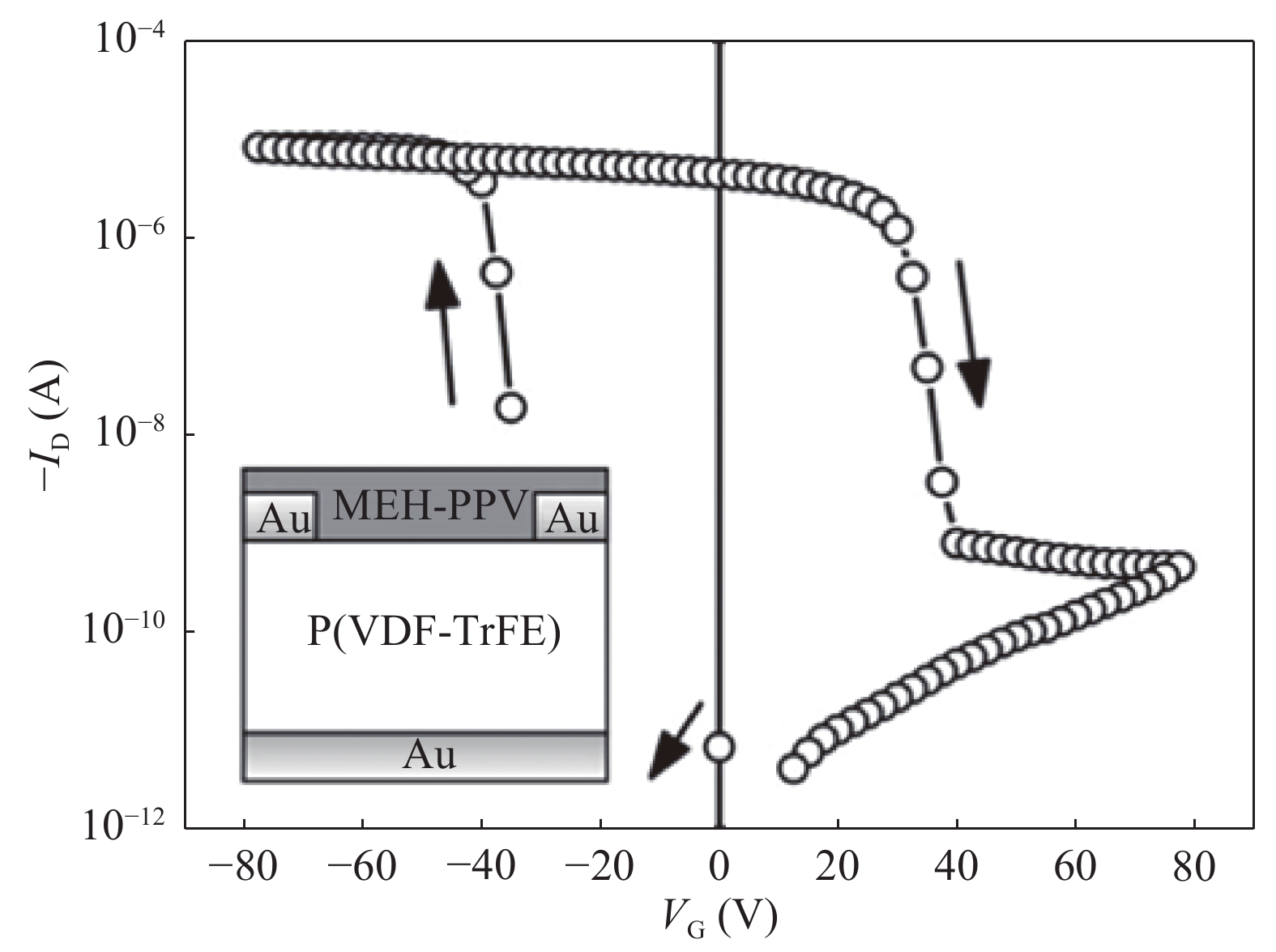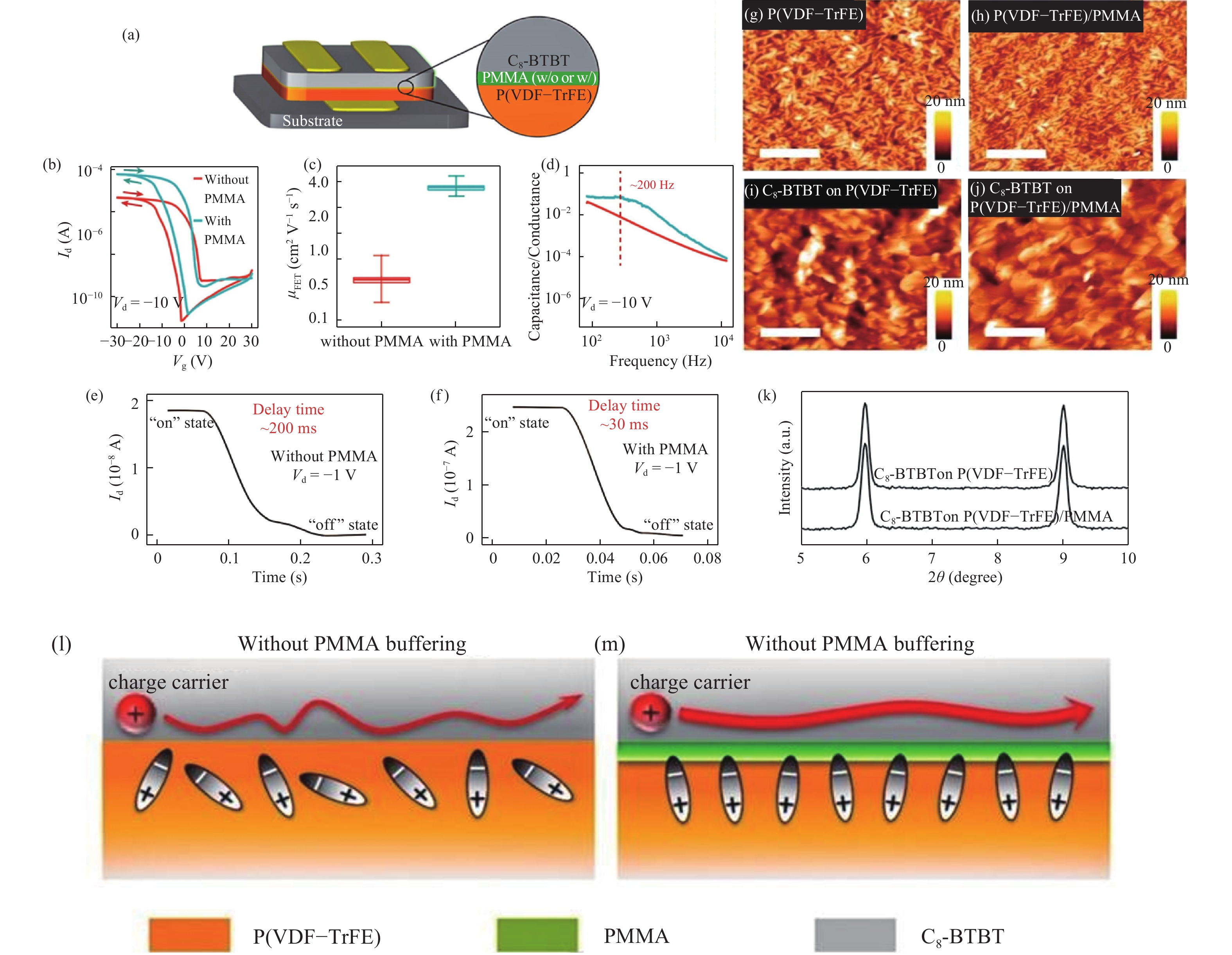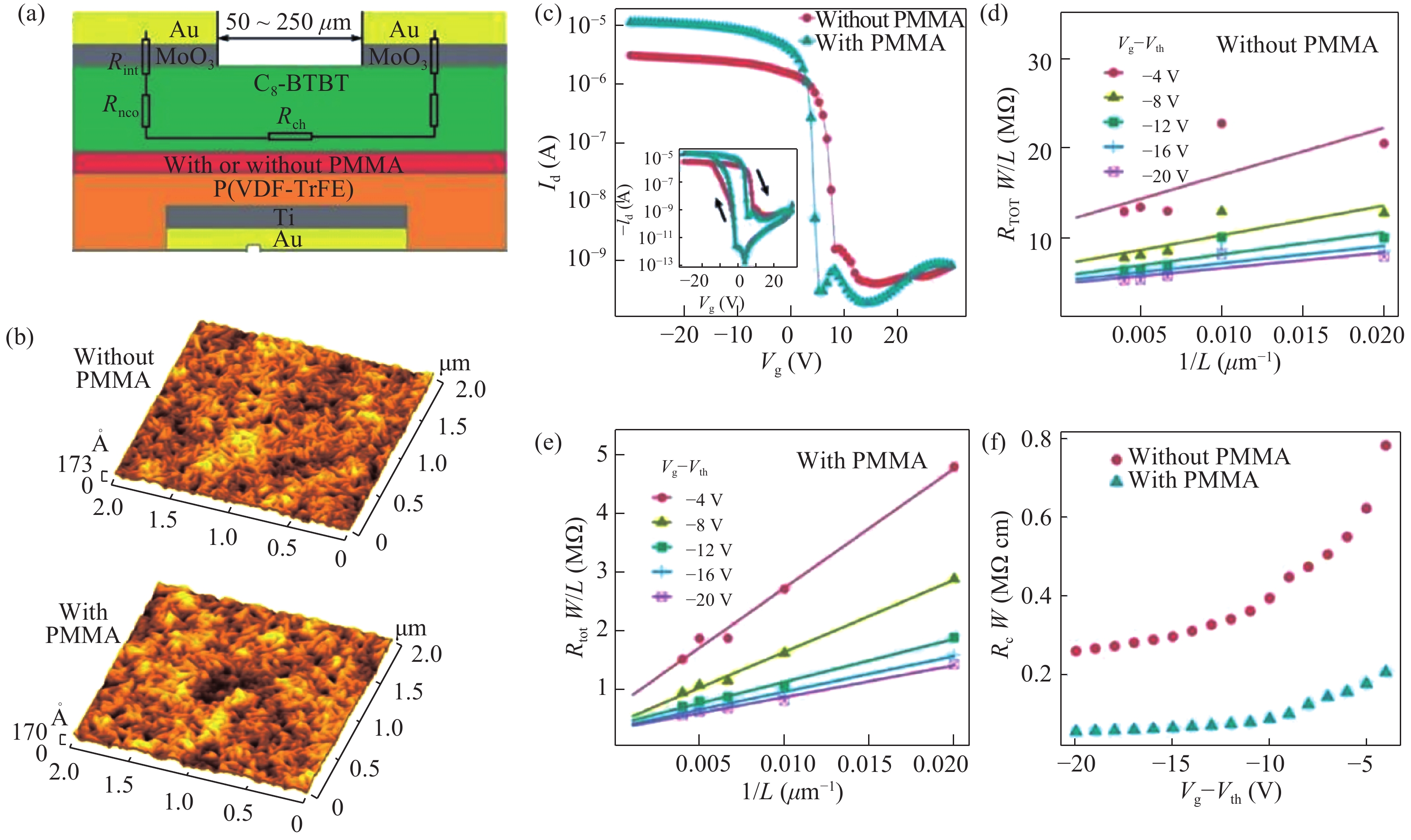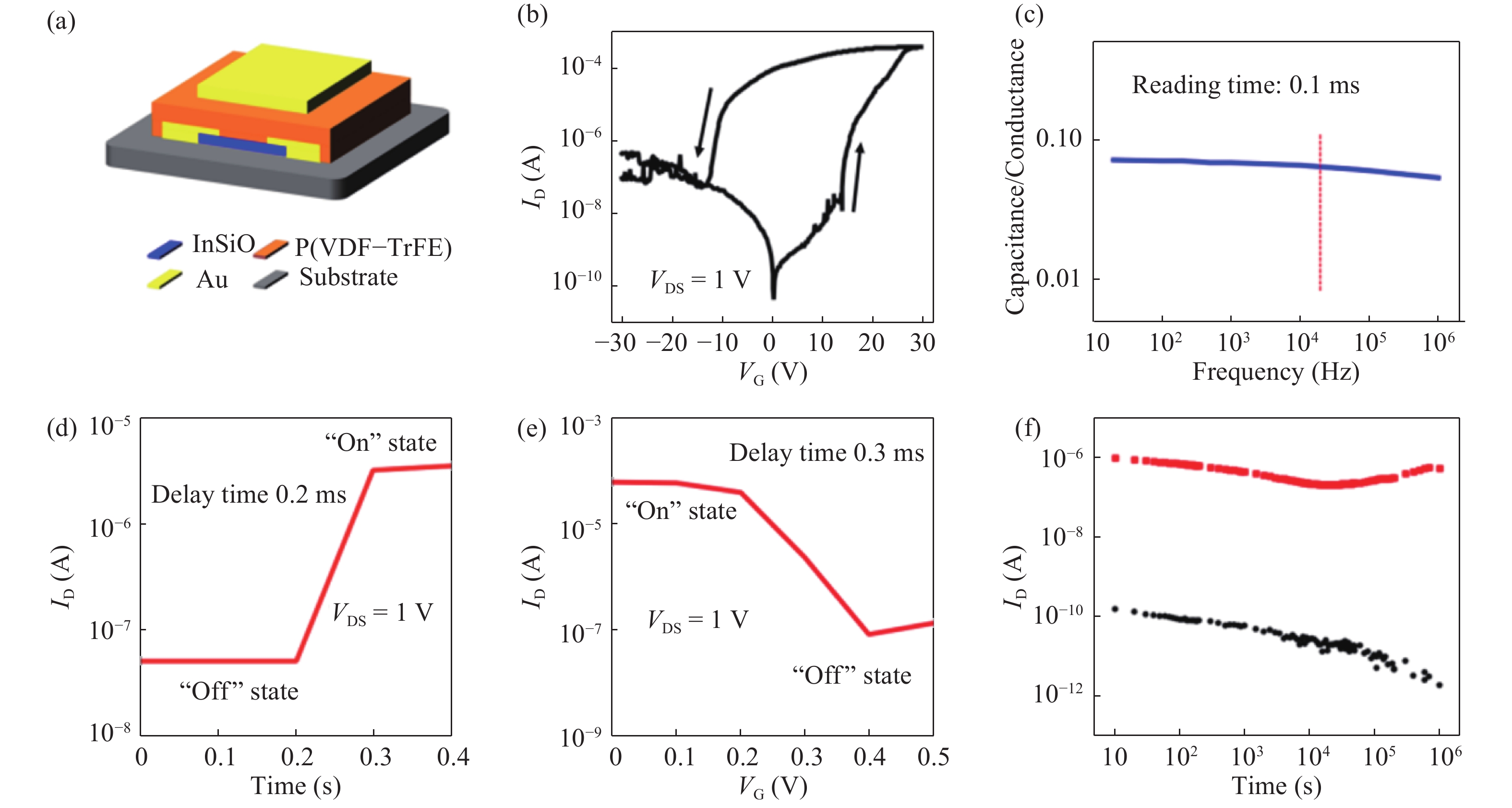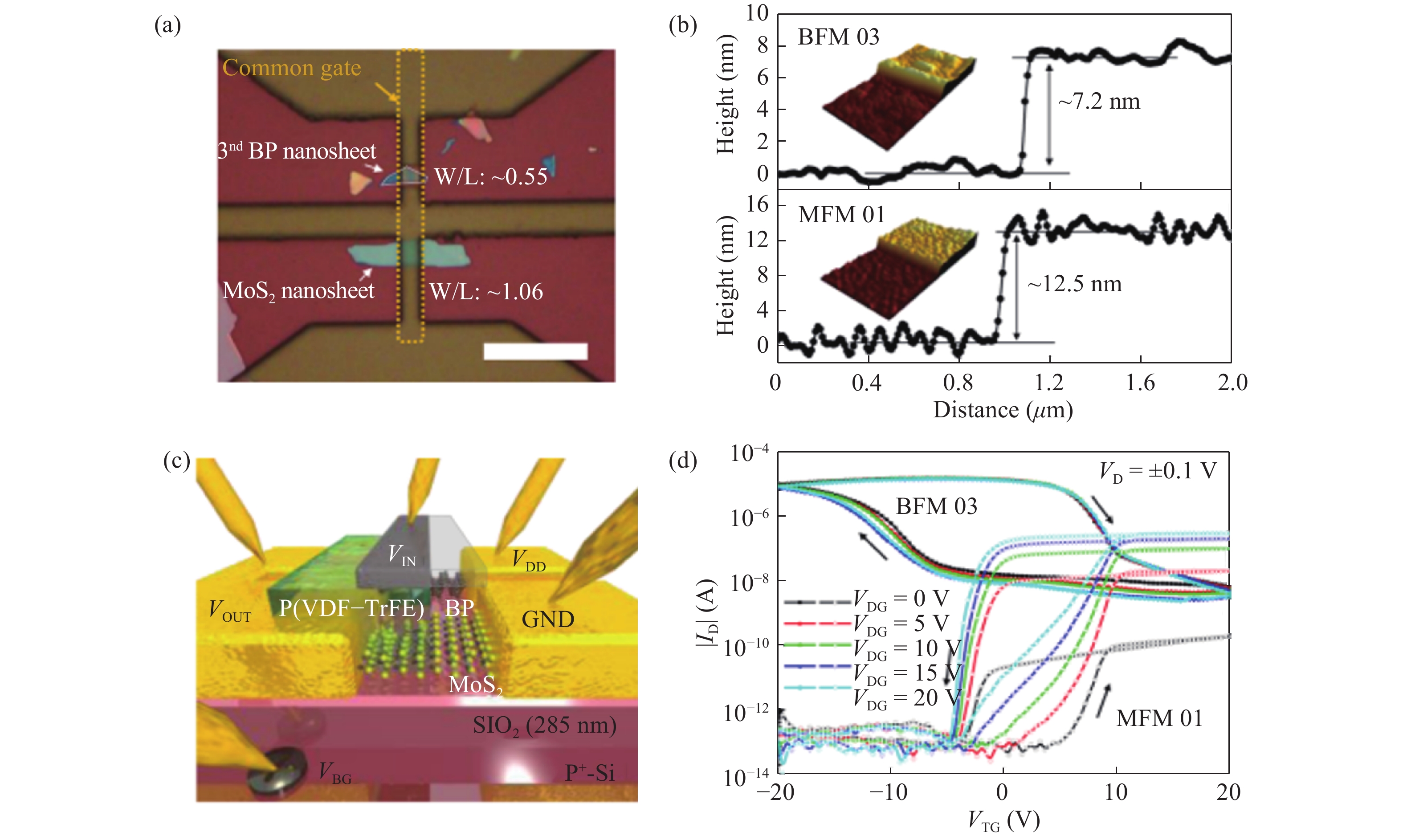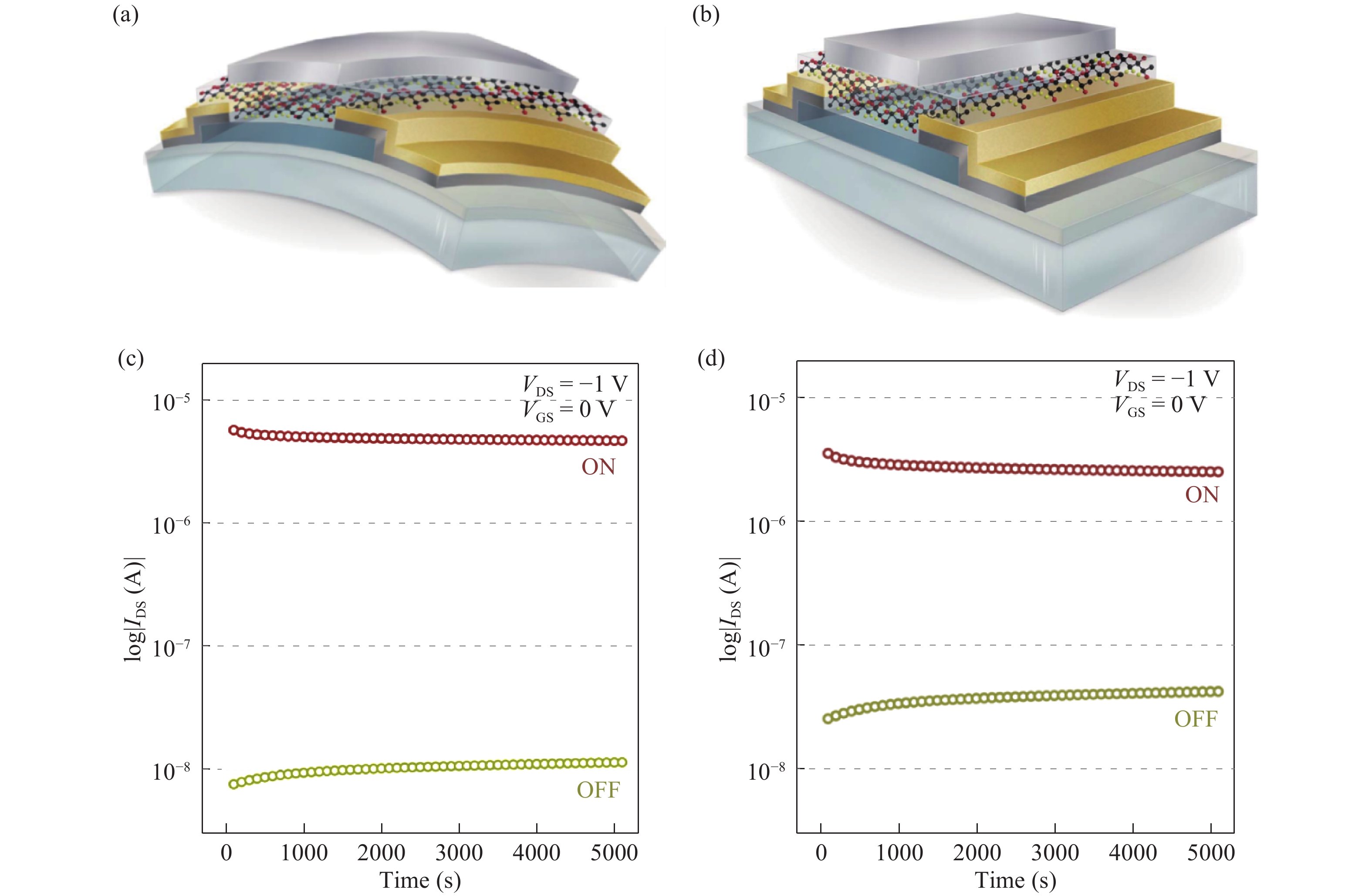| Citation: |
Yujia Zhang, Haiyang Wang, Lei Zhang, Xiaomeng Chen, Yu Guo, Huabin Sun, Yun Li. Field-effect transistor memories based on ferroelectric polymers[J]. Journal of Semiconductors, 2017, 38(11): 111001. doi: 10.1088/1674-4926/38/11/111001
****
Y J Zhang, H Y Wang, L Zhang, X M Chen, Y Guo, H B Sun, Y Li. Field-effect transistor memories based on ferroelectric polymers[J]. J. Semicond., 2017, 38(11): 111001. doi: 10.1088/1674-4926/38/11/111001.
|
Field-effect transistor memories based on ferroelectric polymers
DOI: 10.1088/1674-4926/38/11/111001
More Information
-
Abstract
Field-effect transistors based on ferroelectrics have attracted intensive interests, because of their non-volatile data retention, rewritability, and non-destructive read-out. In particular, polymeric materials that possess ferroelectric properties are promising for the fabrications of memory devices with high performance, low cost, and large-area manufacturing, by virtue of their good solubility, low-temperature processability, and good chemical stability. In this review, we discuss the material characteristics of ferroelectric polymers, providing an update on the current development of ferroelectric field-effect transistors (Fe-FETs) in non-volatile memory applications. -
References
[1] Chavan A A, Ramaswamy D V N, Tao Q. Methods of forming ferroelectric capacitors. Evgeny Tsymbal Publications, 2006: 22[2] Chen Y Q, Liu Y L, Wang B. Minimum size of 180 degree domains in ferroelectric thin films covered by electrodes. Appl Math Mech, 2006, 27(8): 1031 doi: 10.1007/s10483-006-0803-1[3] Valasek L. Piezo-electric and allied phenomena in Rochelle salt. Phys Rev, 1921, 17: 475 doi: 10.1103/PhysRev.17.475[4] Furukawa T, Nakajima T, Takahashi Y. Factor governing ferroelectric switching characteristics of thin VDF/TrFE copolymer films. IEEE Trans Dielectr Electr Insul, 2006, 13(5): 1120 doi: 10.1109/TDEI.2006.247840[5] Furukawa T. Recent advances in ferroelectric polymers. Ferroelectrics, 1990, 104(1): 229 doi: 10.1080/00150199008223826[6] Kepler R G, Anderson R A. Ferroelectric polymers. Adv Phys, 1992, 41(1): 1 doi: 10.1080/00018739200101463[7] Martins P, Lopes A C, Lanceros-Mendez S. Electroactive phases of poly(vinylidene fluoride): determination, processing and applications. Prog Polym Sci, 2014, 39(4): 683 doi: 10.1016/j.progpolymsci.2013.07.006[8] Kang S J, Park Y J, Sung J, et al. Spin cast ferroelectric beta poly(vinylidene fluoride) thin films via rapid thermal annealing. Appl Phys Lett, 2008, 92(1): 012921 doi: 10.1063/1.2830701[9] Li C, Wu P M, Lee S, et al. Flexible dome and bump shape piezoelectric tactile sensors using PVDF-TrFE copolymer. J Microelectromech Syst, 2008, 17(2): 334 doi: 10.1109/JMEMS.2007.911375[10] Cavallini M. Status and perspectives in thin films and patterning of spin crossover compounds. Phys Chem Chem Phys, 2012, 14(34): 11867 doi: 10.1039/c2cp40879a[11] Dietze M, Es-Souni M. Structural and functional properties of screen-printed PZT–PVDF-TrFE composites. Sens Actuators A, 2008, 143(2): 329 doi: 10.1016/j.sna.2007.11.016[12] Ducharme S, Bune A V, Blinov L M, et al. Critical point in ferroelectric Langmuir-Blodgett polymer films. Phys Rev B, 1998, 57(1): 25 doi: 10.1103/PhysRevB.57.25[13] Persano L, Dagdeviren C, Su Y, et al. High performance piezoelectric devices based on aligned arrays of nanofibers of poly(vinylidenefluoride-co-trifluoroethylene). Nat Commun, 2013, 4(3): 67 doi: 10.1038/ncomms2639[14] Delongchamp D M, Vogel B M, Jung Y, et al. Variations in semiconducting polymer microstructure and hole mobility with spin-coating speed. Chem Mater, 2005, 17(23): 5610 doi: 10.1021/cm0513637[15] Nguyen H T, Nguyen L T T, Nguyen T T, et al. Synthesis of hyperbranched conjugated polymers based on 3-hexylthiophene, triphenylamine and benzo [c] [1,2,5] thiadiazole moieties: convenient synthesis through suzuki polymerization and impact of structures on optical properties. J Polym Res, 2014, 21(9): 1[16] Park M S, Joo W, Kim J K. Porous structures of polymer films prepared by spin coating with mixed solvents under humid condition. Langmuir, 2006, 22(10): 4594 doi: 10.1021/la053009t[17] Lau K, Liu Y, Chen H, et al. Effect of annealing temperature on the morphology and piezoresponse characterisation of poly(vinylidene fluoride-trifluoroethylene) films via scanning probe microscopy. Adv Condens Matter Phys, 2013, 2013(1): 1 doi: 10.1155/2013/435938[18] Schick M J. Aggregation processes in solution. J Polym Sci C, 1984, 22(1): 50.[19] Kotsuki K, Tanaka H, Obata S, et al. The importance of spinning speed in fabrication of spin-coated organic thin film transistors: film morphology and field effect mobility. Appl Phys Lett, 2014, 104(23): 233306 doi: 10.1063/1.4883216[20] Feng T T, Xie D, Zang Y Y, et al. Temperature control of P(VDF-TrFE) copolymer thin films. Integr Ferroelectr, 2013, 141(1): 187 doi: 10.1080/10584587.2012.694748[21] Mao D, Quevedo-Lopez M A, Stiegler H, et al. Optimization of poly(vinylidene fluoride-trifluoroethylene) films as non-volatile memory for flexible electronics. Org Electron, 2010, 11(5): 925 doi: 10.1016/j.orgel.2010.02.012[22] Ducharme S, Reece T J, Othon C M, et al. Ferroelectric polymer Langmuir-Blodgett films for nonvolatile memory applications. IEEE Trans Device Mater Reliab, 2006, 5(4): 720 doi: 10.1109/TDMR.2005.860818[23] Gerber A, Fitsilis M, Waser R, et al. Ferroelectric field effect transistors using very thin ferroelectric polyvinylidene fluoride copolymer films as gate dielectrics. J Appl Phys, 2010, 107(12): 124119 doi: 10.1063/1.3437638[24] Brondijk J J, Asadi K, Blom P W M, et al. Physics of organic ferroelectric field-effect transistors. J Polym Sci B, 2011, 50(1): 47 doi: 10.1002/polb.22363[25] Naber R C G, Tanase C, Blom P W M, et al. High-performance solution-processed polymer ferroelectric field-effect transistors. Nat Mater, 2005, 4(3): 243 doi: 10.1038/nmat1329[26] Naber R C G, Massolt J, Spijkman M, et al. Origin of the drain current bistability in polymer ferroelectric field-effect transistors. Appl Phys Lett, 2007, 90(11): 142 doi: 10.1063/1.1533844[27] Reece T J, Gerber A, Kohlstedt H, et al. Investigation of state retention in metal–ferroelectric–insulator–semiconductor structures based on Langmuir–Blodgett copolymer films. J Appl Phys, 2010, 108(2): 044103[28] Zheng Y, Ni G X, Toh C T, et al. Gate-controlled nonvolatile graphene-ferroelectric memory. Appl Phys Lett, 2009, 94(16): 666 doi: 10.1063/1.2749841[29] Naber R C G, Asadi K, Blom P W M, et al. Organic Nonvolatile Memory Devices Based on Ferroelectricity[J]. Advanced Materials, 2010, 22(9):933-45. doi: 10.1002/adma.200900759[30] Naber R C G, De Boer B, Blom P W M, et al. Low-voltage polymer field-effect transistors for nonvolatile memories. Appl Phys Lett, 2005, 87(20): 166[31] Sirringhaus H, Brown P J, Friend R H, et al. Two-dimensional charge transport in self-organized, high-mobility conjugated polymers. Nature, 1999, 401(6754): 685 doi: 10.1038/44359[32] Steudel S, De Vusser S, De Jonge S, et al. Influence of the dielectric roughness on the performance of pentacene transistors. Appl Phys Lett, 2004, 85(19): 4400 doi: 10.1063/1.1815042[33] Naber R C G, Mulder M, Boer B D, et al. High charge density and mobility in poly(3-hexylthiophene) using a polarizable gate dielectric. Org Electron, 2006, 7(3): 132 doi: 10.1016/j.orgel.2005.11.007[34] Laudari A, Guha S. Bandlike transport in ferroelectric-based organic field-effect transistors. Phys Rev Appl, 2016, 6(4): 044007 doi: 10.1103/PhysRevApplied.6.044007[35] Narayanan Unni K N, De Bettignies R, Dabos-Seignon S, et al. A nonvolatile memory element based on an organic field-effect transistor. Appl Phys Lett, 2004, 85(10): 1823 doi: 10.1063/1.1788887[36] Nguyen C A, Lee P S, Mhaisalkar S G. Investigation of turn-on voltage shift in organic ferroelectric transistor with high polarity gate dielectric. Org Electron, 2007, 8(4): 415 doi: 10.1016/j.orgel.2007.01.010[37] Sun Y L, Xie D, Xu J L, et al. Pentacene organic ferroelectric transistors with [P(VDF-TrFE)] gate by Langmuir- Blodgett process. J Appl Phys, 2015, 118: 115501 doi: 10.1063/1.4930867[38] Gundlach D J, Jackson T N, Schlom D G, et al. Solvent-induced phase transition in thermally evaporated pentacene films. Appl Phys Lett, 1999, 74(22): 3302 doi: 10.1063/1.123325[39] Nguyen C A, Mhaisalkar S G, Ma J, et al. Enhanced organic ferroelectric field effect transistor characteristics with strained poly(vinylidene fluoride-trifluoroethylene) dielectric. Org Electron, 2008, 9(6): 1087 doi: 10.1016/j.orgel.2008.08.012[40] Kusuma D Y, Nguyen C A, Lee P S. Enhanced ferroelectric switching characteristics of P(VDF-TrFE) for organic memory devices. J Phys Chem B, 2010, 114(42): 13289 doi: 10.1021/jp105249f[41] Matsuo Y, Ijichi T, Yamada H, et al. Electrical properties and memory effect in the field effect transistor based on organic ferroelectric insulator and pentacene. Centr Europ J Phys, 2004, 2(2): 357[42] Matsuo Y, Ijichi T, Hatori J, et al. Fabrication and electrical properties of field effect transistor based on ferroelectric insulator and pentacene film. Curr Appl Phys, 2004, 4(2): 210[43] Schroeder R, Majewski L, Grell M. All-organic permanent memory transistor using an amorphous, spin-cast ferroelectric-like gate insulator. Adv Mater, 2004, 16(7): 633 doi: 10.1002/(ISSN)1521-4095[44] Schroeder R, Majewski L A, Voigt M, et al. Memory performance and retention of an all-organic ferroelectric-like memory transistor. IEEE Electron Device Lett, 2005, 26(2): 69 doi: 10.1109/LED.2004.841186[45] Noda K, Ishida K, Kubono A, et al. Remanent polarization of evaporated films of vinylidene fluoride oligomers. J Appl Phys, 2003, 93(5): 2866 doi: 10.1063/1.1540231[46] Matsumoto A, Horie S, Yamada H, et al. Ferro-and piezoelectric properties of vinylidene fluoride oligomer thin film fabricated on flexible polymer film. Appl Phys Lett, 2007, 90(20): 202906 doi: 10.1063/1.2740117[47] Sun H, Wang Q, Li Y, et al. Boost up carrier mobility for ferroelectric organic transistor memory via buffering interfacial polarization fluctuation. Sci Rep, 2014, 4: 7227 doi: 10.1038/srep07227[48] Liu C, Xu Y, Noh Y Y. Contact engineering in organic field-effect transistors. Mater Today, 2015, 18(2): 79 doi: 10.1016/j.mattod.2014.08.037[49] Muccini M. A bright future for organic field-effect transistors. Nat Mater, 2006, 5(8):605 doi: 10.1038/nmat1699[50] Klauk H, Schmid G, Radlik W, et al. Contact resistance in organic thin film transistors. Solid-State Electron, 2003, 47(2): 297 doi: 10.1016/S0038-1101(02)00210-1[51] Minari T, Miyadera T, Tsukagoshi K, et al. Scaling effect on the operation stability of short-channel organic single-crystal transistors. Appl Phys Lett, 2007, 91(6): 063506 doi: 10.1063/1.2767987[52] Herlogsson L, Crispin X, Tierney S, et al. Polyelectrolyte-gated organic complementary circuits operating at low power and voltage. Adv Mater, 2011, 23(40): 4684 doi: 10.1002/adma.201101757[53] Sun H, Yin Y, Wang Q, et al. Reducing contact resistance in ferroelectric organic transistors by buffering the semiconductor/dielectric interface. Appl Phys Lett, 2015, 117(23): 12337[54] Cheng C H, Yeh F S, Chin A. Low-power high-performance non-volatile memory on a flexible substrate with excellent endurance. Adv Mater, 2011, 23(7): 902 doi: 10.1002/adma.v23.7[55] Baeg K J, Khim D, Kim J, et al. Organic electronics: high-performance top-gated organic field-effect transistor memory using electrets for monolithic printed flexible NAND flash Memory. Adv Funct Mater, 2012, 22(14): 2881 doi: 10.1002/adfm.v22.14[56] Yoon S M, Yang S, Byun C W, et al. Nonvolatile memory thin-film transistors using an organic ferroelectric gate insulator and an oxide semiconducting channel. Semicond Sci Technol, 2011, 26(3): 034007 doi: 10.1088/0268-1242/26/3/034007[57] Lee K H, Lee G, Lee K, et al. High-mobility nonvolatile memory thin-film transistors with a ferroelectric polymer interfacing ZnO and Pentacene channels. Adv Mater, 2010, 21(42): 4287[58] Yoon S, Yang S, Byun C, et al. Fully Transparent non-volatile memory thin-film transistors using an organic ferroelectric and oxide semiconductor below 200 °C. Adv Funct Mater, 2010, 20(6): 921 doi: 10.1002/adfm.200902095[59] Yoon S M, Yang S, Byun C W, et al. Nonvolatile memory thin-film transistors using an organic ferroelectric gate insulator and an oxide semiconducting channel. Semicond Sci Technol, 2011, 26(3): 034007 doi: 10.1088/0268-1242/26/3/034007[60] Lee K H, Lee G, Lee K, et al. High-mobility nonvolatile memory thin-film transistors with a ferroelectric polymer interfacing ZnO and Pentacene channels. Adv Mater, 2010, 21(42): 4287[61] Noh S H, Choi W, Min S O, et al. ZnO-based nonvolatile memory thin-film transistors with polymer dielectric/ferroelectric double gate insulators. Appl Phys Lett, 2007, 90(25): 253504. doi: 10.1063/1.2749841[62] Lee G G, Fujisaki Y, Ishiwara H, et al. Low-voltage operation of ferroelectric gate thin film transistors using indium gallium zinc oxide-channel and ferroelectric polymer poly(vinylidene fluoride-trifluoroethylene). Appl Phys Express, 2011, 4(9): 544[63] Yoon S M, Yang S, Ryu M K, et al. Oxide semiconductor-based organic/inorganic hybrid dual-gate nonvolatile memory thin-film transistor. IEEE Trans Electron Devices, 2011, 58(7): 2135 doi: 10.1109/TED.2011.2139212[64] Lee G G, Tokumitsu E, Yoon S M, et al. The flexible non-volatile memory devices using oxide semiconductors and ferroelectric polymer poly(vinylidene fluoride-trifluoroethylene). Appl Phys Lett, 2011, 99(1): 243[65] Breemen A V, Kam B, Cobb B, et al. Ferroelectric transistor memory arrays on flexible foils. Org Electron, 2013, 14(8): 1966 doi: 10.1016/j.orgel.2013.04.025[66] Yoon S M, Yang S, Park S H K. Flexible nonvolatile memory thin-film transistor using ferroelectric copolymer gate insulator and oxide semiconducting channel. J Electrochem Soc, 2011, 158(9): H892 doi: 10.1149/1.3609842[67] Lee G G, Tokumitsu E, Yoon S M, et al. The flexible non-volatile memory devices using oxide semiconductors and ferroelectric polymer poly(vinylidene fluoride-trifluoroethylene). Appl Phys Lett, 2011, 99(1): 243[68] Park C H, Lee G, Lee K H, et al. Enhancing the retention properties of ZnO memory transistor by modifying the channel/ferroelectric polymer interface. Appl Phys Lett, 2009, 95(15): 386[69] Lee K H, Lee G, Lee K, et al. High-mobility nonvolatile memory thin-film transistors with a ferroelectric polymer interfacing ZnO and Pentacene channels. Adv Mater, 2010, 21(42): 4287[70] Yoon S M, Yang S H, Park S H K, et al. Effect of ZnO channel thickness on the device behaviour of nonvolatile memory thin film transistors with double-layered gate insulators of Al2O3 and ferroelectric polymer. J Phys D, 2009, 42(24): 245101 doi: 10.1088/0022-3727/42/24/245101[71] Park C H, Lee K H, Lee B H, et al. Channel/ferroelectric interface modification in ZnO non-volatile memory TFT with P (VDF-TrFE) polymer. J Mater Chem, 2010, 20(13): 2638 doi: 10.1039/B921732K[72] Nomura K, Ohta H, Takagi A, et al. Room-temperature fabrication of transparent flexible thin-film transistors using amorphous oxide semiconductors. Nature, 2004, 432(7016): 488 doi: 10.1038/nature03090[73] Petti L, Munzenrieder N, Salvatore G A, et al. Influence of mechanical bending on flexible InGaZnO-based ferroelectric memory TFTs. IEEE Trans Electron Devices, 2014, 61(4): 1085 doi: 10.1109/TED.2014.2304307[74] Fortunato E, Barquinha P, Martins R. Oxide semiconductor thin-film transistors: a review of recent advances. Adv Mater, 2012, 43(34): 2945[75] Tomai S, Nishimura M, Itose M, et al. High-performance thin film transistor with amorphous In2O3-SnO2-ZnO channel layer. Jpn J Appl Phys, 2013, 51(3S): 03CB01[76] Maruyama T, Tago T. Germanium- and silicon-doped indium-oxide thin films prepared by radio-frequency magnetron sputtering. Appl Phys Lett, 1994, 64(11):1395 doi: 10.1063/1.111894[77] Kumomi H, Yaginuma S, Omura H, et al. Materials, devices, and circuits of transparent amorphous-oxide semiconductor. J Display Technol, 2009, 5(12): 531 doi: 10.1109/JDT.2009.2025521[78] Aikawa S, Darmawan P, Yanagisawa K, et al. Thin-film transistors fabricated by low-temperature process based on Ga- and Zn-free amorphous oxide semiconductor. Appl Phys Lett, 2013, 102(10): 102101 doi: 10.1063/1.4794903[79] Kizu T, Aikawa S, Mitoma N, et al. Low-temperature processable amorphous In–W–O thin-film transistors with high mobility and stability. Appl Phys Lett, 2014, 104(15): 3787[80] Nomura K, Ohta H, Takagi A, et al. Room-temperature fabrication of transparent flexible thin-film transistors using amorphous oxide semiconductors. Nature, 2004, 432(7016): 488 doi: 10.1038/nature03090[81] Wang Y, Kizu T, Song L, et al. High-performance non-volatile field-effect transistor memories using an amorphous oxide semiconductor and ferroelectric polymer. J Mater Chem C, 2016, 4(34): 7917 doi: 10.1039/C6TC01768A[82] Li Y, Liu C, Pan L, et al. Electrical switching behavior from all-polymer-based system of semiconductor/ferroelectrics/semiconductor. Appl Phys Lett, 2011, 98(17): 83[83] Kusuma D Y, Lee P S. Ferroelectric tunnel junction memory devices made from monolayers of vinylidene fluoride oligomers. Adv Mater, 2012, 24(30): 4163 doi: 10.1002/adma.201104476[84] Berger C, Song Z, Li T, et al. Ultrathin epitaxial graphite: 2D electron gas properties and a route toward graphene-based nanoelectronics. J Phys Chem B, 2004, 108(52): 19912 doi: 10.1021/jp040650f[85] Berger C, Song Z, Li X, et al. Electronic confinement and coherence in patterned epitaxial graphene. Science, 2006, 312: 1191 doi: 10.1126/science.1125925[86] Lemme M C, Echtermeyer T J, Baus M, et al. A graphene field-effect device. IEEE Electron Device Lett, 2007, 28(4): 282 doi: 10.1109/LED.2007.891668[87] Wang X, Ouyang Y, Li X, et al. Room-temperature all-semiconducting sub-10-nm graphene nanoribbon field-effect transistors. Phys Rev Lett, 2008, 100: 206803 doi: 10.1103/PhysRevLett.100.206803[88] Han M Y, Özyilmaz B, Zhang Y, et al. Energy band-gap engineering of graphene nanoribbons. Phys Rev Lett, 2007, 98: 206805 doi: 10.1103/PhysRevLett.98.206805[89] Lin Y M, Avouris P. Strong suppression of electrical noise in bilayer graphene nanodevices.. Nano Lett, 2008, 8(8): 2119 doi: 10.1021/nl080241l[90] Radisavljevic B, Radenovic A, Brivio J, et al. Single-layer MoS2 transistors. Nat Nanotechnol, 2011, 6(3): 147 doi: 10.1038/nnano.2010.279[91] Radisavljevic B, Whitwick M B, Kis A. Integrated circuits and logic operations based on single-layer MoS2. Acs Nano, 2011, 5(12): 9934 doi: 10.1021/nn203715c[92] Das S, Appenzeller J. WSe2 field effect transistors with enhanced ambipolar characteristics. Appl Phys Lett, 2013, 103(10): 1497[93] Fang H, Chuang S, Chang T C, et al. High-performance single layered WSe2 p-FETs with chemically doped contacts. Nano Lett, 2012, 12(7): 3788 doi: 10.1021/nl301702r[94] Lee H S, Min S W, Chang Y G, et al. MoS2 nanosheet phototransistors with thickness-modulated optical energy gap. Nano Lett, 2012, 12: 3695 doi: 10.1021/nl301485q[95] Radisavljevic B, Kis A. Mobility engineering and a metal-insulator transition in monolayer MoS2. Nat Mater, 2013, 12(9): 815 doi: 10.1038/nmat3687[96] Kim S, Konar A, Hwang W S, et al. High-mobility and low-power thin-film transistors based on multilayer MoS2 crystals. Nat Commun, 2012, 3(8): 1011[97] Li L, Yu Y, Ye G J, et al. Black phosphorus field-effect transistors. Nat Nanotechnol, 2014, 9(5): 372 doi: 10.1038/nnano.2014.35[98] Han Liu, Adam T. Neal, Zhen Zhu, et al. Phosphorene: an unexplored 2D semiconductor with a high hole mobility. ACS Nano, 2014, 8: 4033 doi: 10.1021/nn501226z[99] Zhang S, Yang J, Xu R, et al. Extraordinary photoluminescence and strong temperature/angle-dependent Raman responses in few-layer phosphorene. Acs Nano, 2014, 8(9): 9590 doi: 10.1021/nn503893j[100] Das S, Zhang W, Demarteau M, et al. Tunable transport gap in phosphorene. Nano Lett, 2014, 14(10): 5733 doi: 10.1021/nl5025535[101] Du Y, Liu H, Deng Y, et al. Device perspective for black phosphorus field-effect transistors: contact resistance, ambipolar behavior, and scaling. Acs Nano, 2014, 8(10): 10035 doi: 10.1021/nn502553m[102] Das S, Demarteau M, Roelofs A K. Ambipolar phosphorene field effect transistor. Acs Nano, 2014, 8(11): 11730 doi: 10.1021/nn505868h[103] Lee Y T, Kwon H, Kim J S, et al. Nonvolatile ferroelectric memory circuit using black phosphorus nanosheet-based field-effect transistors with P(VDF-TrFE) polymer. Acs Nano, 2015, 9(10): 10394 doi: 10.1021/acsnano.5b04592[104] Naber R C G, Asadi K, Blom P W M, et al. Organic nonvolatile memory devices based on ferroelectricity. Adv Mater, 2010, 22(9): 933 doi: 10.1002/adma.200900759[105] Park Y J, Bae I S, Kang S J, et al. Control of thin ferroelectric polymer films for non-volatile memory applications. IEEE Trans Dielectr Electr Insul, 2010, 17(4): 1135 doi: 10.1109/TDEI.2010.5539685[106] Lee K H, Lee G, Lee K, et al. High-mobility nonvolatile memory thin-film transistors with a ferroelectric polymer interfacing ZnO and Pentacene channels. Adv Mater, 2010, 21(42): 4287[107] Naber R C G, De Boer B, Blom P W M, et al. Low-voltage polymer field-effect transistors for nonvolatile memories. Appl Phys Lett, 2005, 87(20): 166[108] Lee G G, Tokumitsu E, Yoon S M, et al. The flexible non-volatile memory devices using oxide semiconductors and ferroelectric polymer poly(vinylidene fluoride-trifluoroethylene). Appl Phys Lett, 2011, 99(1): 243[109] Yoon S, Yang S, Byun C, et al. Fully transparent non-volatile memory thin-film transistors using an organic ferroelectric and oxide semiconductor below 200 °C. Adv Funct Mater, 2010, 20(6): 921 doi: 10.1002/adfm.200902095[110] Yoon S M, Yang S, Byun C W, et al. Nonvolatile memory thin-film transistors using an organic ferroelectric gate insulator and an oxide semiconducting channel. Semicond Sci Technol, 2011, 26(3): 034007 doi: 10.1088/0268-1242/26/3/034007[111] Korotcenkov G. Metal oxides for solid-state gas sensors: what determines our choice. Mater Sci Eng B, 2007, 139(1): 1 doi: 10.1016/j.mseb.2007.01.044[112] Batzill M, Diebold U. The surface and materials science of tin oxide. Prog Surf Sci, 2005, 79: 47 doi: 10.1016/j.progsurf.2005.09.002[113] Ogo Y, Hiramatsu H, Nomura K, et al. p-channel thin-film transistor using p-type oxide semiconductor, SnO. Appl Phys Lett, 2008, 93(3): 488[114] Yabuta H, Kaji N, Hayashi R, et al. Sputtering formation of p-type SnO thin-film transistors on glass toward oxide complimentary circuits. Appl Phys Lett, 2010, 97(7): 488[115] Caraveo-Frescas J A, Nayak P K, Al-Jawhari H A, et al. Record mobility in transparent p-type tin monoxide films and devices by phase engineering. Acs Nano, 2013, 7(6): 5160 doi: 10.1021/nn400852r[116] Ogo Y, Hiramatsu H, Nomura K, et al. Tin monoxide as an s-orbital-based p-type oxide semiconductor: Electronic structures and TFT application. Phys Status Solidi, 2009, 206(9): 2187 doi: 10.1002/pssa.v206:9[117] Caraveofrescas J A, Khan M A, Alshareef H N. Polymer ferroelectric field-effect memory device with SnO channel layer exhibits record hole mobility. Sci Rep, 2014, 4(23): 5243 doi: 10.1002/pssa.v206:9[118] Haibin Su, Alejandro Strachan, and William A. Goddard. Density functional theory and molecular dynamics studies on energetics and kinetics for electro-active polymers: PVDF and P(VDF–TrFE)[C]. 2005 APS March Meeting, American Physical Society, 2005[119] Sun H. Organic ferroelectric field-effect memory devices. Nanjing: Nanjing University Press, 2015 -
Proportional views





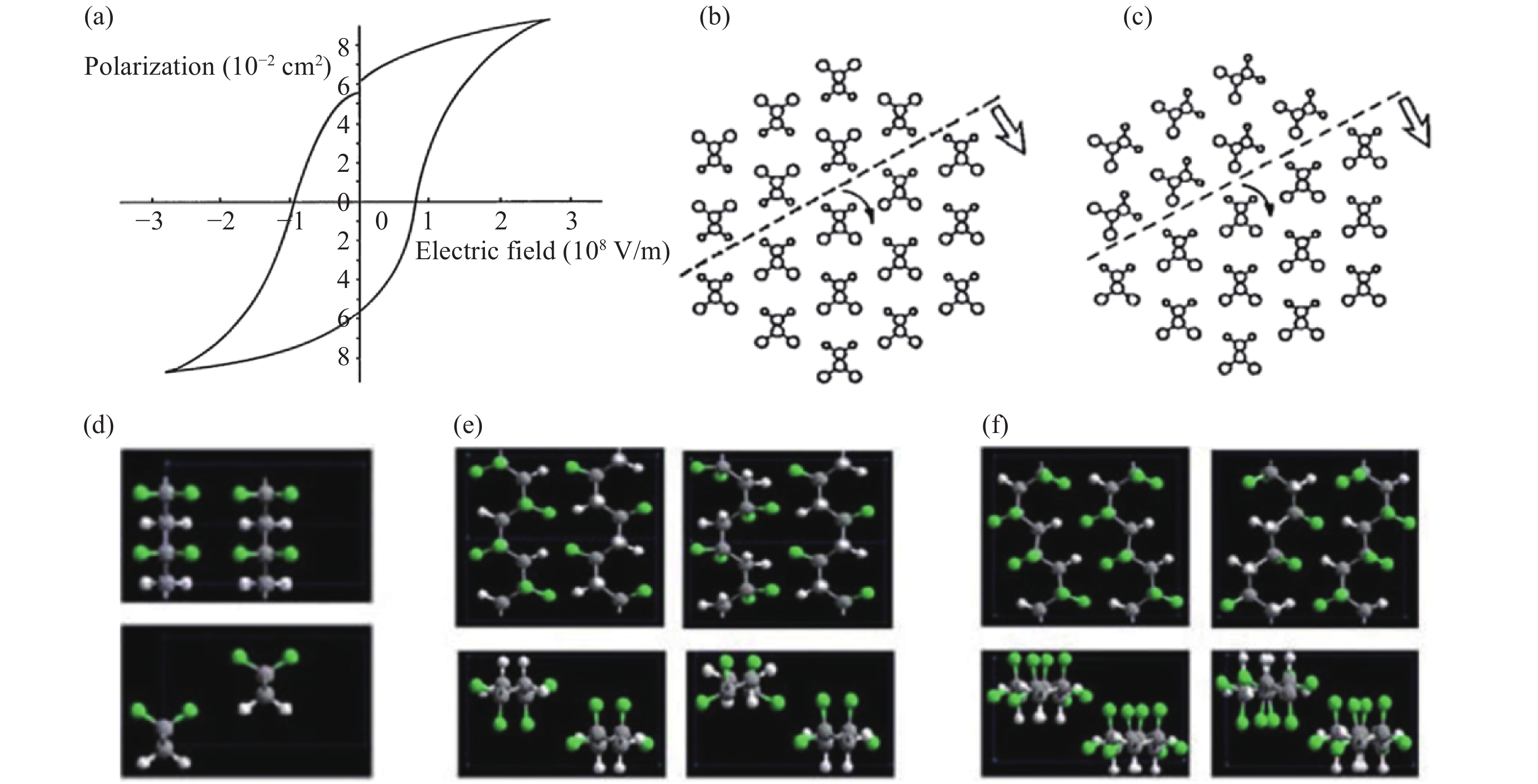
 DownLoad:
DownLoad:




